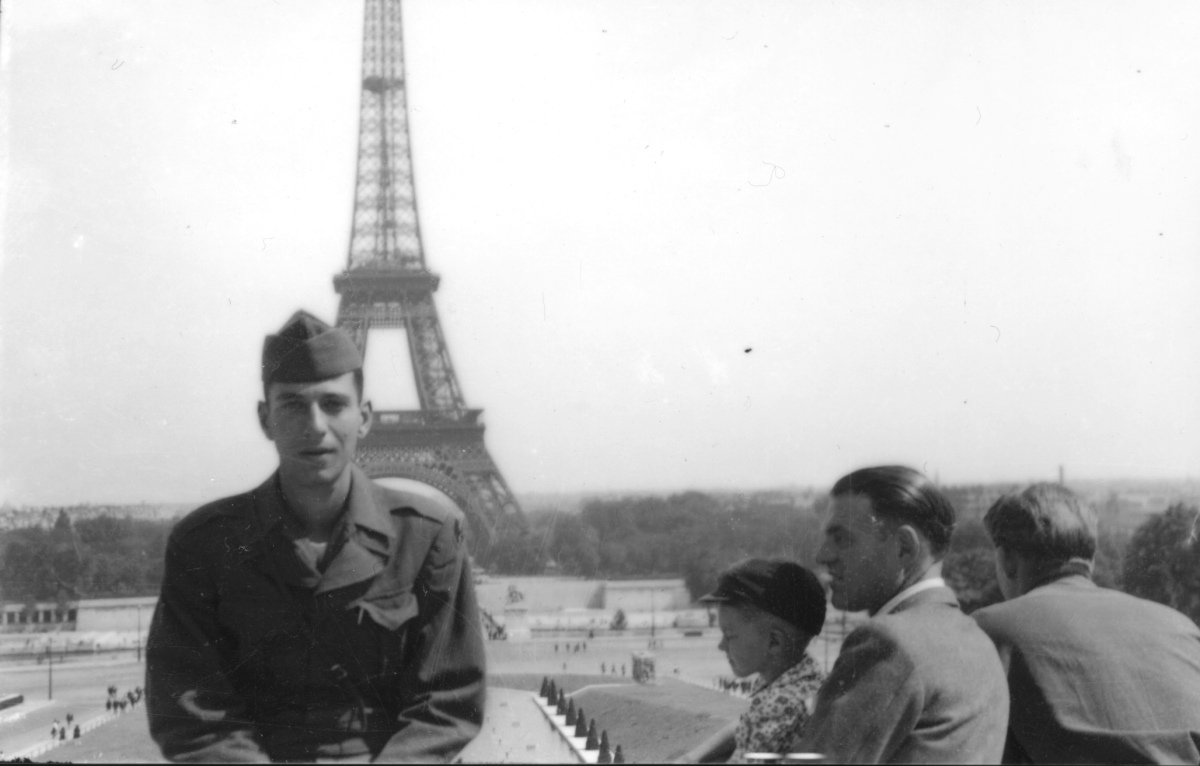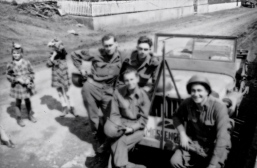Martin Eisenberg was born on December 26, 1924. I know him as Uncle Marty. Everyone, related to him or not, affectionately calls him Uncle Marty too. 
Marty was raised in Queens and graduated from Newtown High School, in Elmhurst, NY. His mother and father, Sara and Louis Eisenberg, were both from Russia and immigrated into the United States. Sara, born in 1898, immigrated in 1911, when she was 13. Louis, born in 1893, immigrated in 1906. Sarah and Louis met in the United States and had three children: Bess, Doris and Martin. Bess Tucker is my grandmother, my father’s mother, Marty’s older sister. She was born in 1916. After the War, Marty attended Adelphi College in Garden City, New York. Adelphi College had been an all women’s school until 1946 and became coeducational to start admitting veterans under the federal GI Bill.
Marty took over the family business while still in college: “Mayfield Hand Laundry – Fine Dry Cleaners” located at 81-11 Northern Boulevard, Across the Street From A&P, Jackson Heights, L.I.. He ran the dry cleaning business for about 25 years until he sold it to Patsy, who had worked for Marty and his father.
A six-month stint at a small stock brokerage firm followed, along with working in his friend’s deli in Deer Park, NY. Then, as a regular customer of P.J. Clarke’s, the management proposed that he’d be the temporary weekend maitre’d; a job that lasted thirty years.
For most of my life, I asked Uncle Marty to go out to dinner on Veteran’s Day. I knew Marty was in World War II but I never had any specifics. He always accepted the dinner invitation but when prompted to talk about the War, he changed his response every time, before dismissing my inquiries altogether. Sometimes he said he was in Paris, sometimes in Germany, sometimes in England; most of the time just Europe. His one word answers were as far as we got. I knew nothing really about his life in the war, even if he really had one — or why if he had, he made nothing of it.
At the end of January 2014, he moved from his apartment on the Upper East Side to an assisted living home in Rochester, NY. The day we cleaned out his apartment after he moved, I found boxes of negatives tucked away in his cupboards. In various states of disrepair, they hadn’t been stored well. They were dirty, ripped, damaged, covered in filth. Many of them were stained a mysterious coffee color that resembled an oil slick. There were some prints as well, similarly ripped, creased, folded, faded. And yet they were there – a basis for figuring out Marty’s war narrative – a story that I had always wanted to know but had never heard. I developed, printed, scanned and researched these images from the 1940s for the past six weeks.
Now, his memory is completely gone. It’s a good day if he remembers who I am – and up until January, I had seen him every day of my life for the past ten years.
The 1940 U.S. Census lists Martin Eisenberg, age 15, almost 16, a white male, in his second year of high school, residing at 3231 83rd Street, Queens, New York. By March 4, 1942, he was enlisted into the Army, three months after he turned 18. The enlistment was “for the duration of the War or other emergency, plus six months, subject to the discretion of the President or otherwise according to law.”
In the photos that I was developing and in some of the prints, a single lightning bolt patch can be seen on most of the men’s uniform. Later, I found more documents cementing Marty’s role in the Army as a Technician 5th Grade in the Signal Corps of the 78th Division. The title “Technician 5th Grade” is not used as a rank anymore.
Fortunately, in the same box that the negatives and prints were in, there were random pieces of paper shoved into the bottom. One of these random papers was a small booklet about 4’’ tall by 3’’ wide entitled: “Lighting – The Story of the 78th Infantry Division”. This booklet tracks the division’s movement from New Jersey to England to France to Belgium and Germany. Tucked inside the front cover of the booklet was an “Enlisted Man’s Temporary Pass” for Martin Eisenberg. This “Enlisted Man’s Temporary Pass” gave Marty permission to visit Liege, Belgium from 800 17 FEB 1945 to 1800 17 Feb 1945. It lists his Army serial number as 32823592 and his Grade as PFC – Private First Class.
Through these images, it’s evident that Marty had Army buddies. There are tons of pictures with his arms around a few guys, grinning. Where are they now? Who were they? Why didn’t he stay in touch with them after the War? I have no idea who they are, what their names are or if they are even alive besides the handwritten scribbles on a few photos. Questioning him about the photos proved to be unfruitful.
The twentieth century continued; the World Wars became a thing of the past. Marty continued to work at the original location of P.J. Clarke’s on 55th Street and Third Avenue until the early 2000s. He moved from his apartment in Jackson Heights, Queens to 160 East 84th Street in Manhattan, the building that I live in, upon my mother’s insistence out of concern for him living alone.
For the past ten years, this is where he has been, summering with us in Southampton, tanning, driving his red Mini Copper convertible and sitting on our couch, commenting on life with many of his standard one-liners:
“Life’s not easy,”
“Life’s not perfect,”
“It doesn’t pay to get old,”
and “Money doesn’t buy you happiness; but who needs happiness?”
As many times as I heard these one-liners, I miss hearing them on a daily basis.
There are also photographs of Marty at the beach, with friends, laughing, smiling, sun-tanning; I’m assuming these were taken in the U.S. pre-War or post-War, in the 1940s.
Most of these narratives, from his time spent in Europe during the War or relaxing on the beaches of New York are unknown, and will remain that way. Stories encapsulated in these negatives and crumpled prints are up to interpretation, malleable. The smiling faces during an era of such violence suggest that in the face of xenophobia and bigotry, there are other forces at work that can physically and mentally battle that hatred.
October 16, 2016: Marty passed away yesterday in Bristol, Rhode Island.
Thanks for teaching me it’s okay to complain, it’s okay to be abrasive , it is okay to whine. Thanks for Mugsy. Thank you Marty for being a grandfather I never had and for being a “great uncle” to many New Yorkers. Will drink a Bloody Mary in your honor . As you’d say, whoopee ! 
























































5 replies on “World War II through Marty Eisenberg’s Photos”
Robert, I can’t express how moved I am by this narrative and the pictures. Obviously I didn’t know Marty then, but it does bring to mind the years that I knew and loved him as a father figure. His relationship with my mom, brother and me was one of great love. Thank you.
LikeLike
Ally,
Thank you for sharing Marty’s remarkable story and photographs.
He has touched a great many people, as have you.
LikeLike
Well said Ally. Thanks for bringing back some great memories and filling in some blanks for me.
It was a privilege (and lots of fun) knowing Marty. I’ll miss him.
X. MI
Ps. Saki? ______.
LikeLike
Ally, I’m an author and living historian/reenactor for the World War II era. Our purpose is recreate as accurately as possible the lives of the civilians and military units of the 1940s. I know a reenacting unit which represents the 78th. They’re based out of Philadelphia PA. They’d love to see these photos and could probably fill in the blanks about your uncle’s service. Here’s their Facebook link if you’re interested: https://www.facebook.com/pg/78th-Infantry-Division-World-War-II-Living-History-Association-144881925547068/about/
LikeLike
Ally, what you did is beautifu! You brought memories of Marty to life Happy e was truly special and wonderful man. I was blessed to be his friend. Your shared memories of him are a blessing to me. Have you thought about sending this to the National WWII museum in New Orleans?
LikeLike